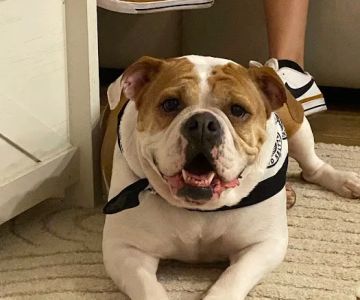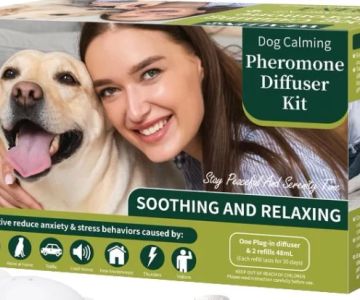How to Manage Anxiety in Older Pets
1. Understanding Anxiety in Older Pets
As pets age, they experience many of the same physical and emotional changes that humans go through. Anxiety in older pets can be triggered by various factors, including health issues, changes in their environment, or a decline in their ability to cope with stress. It's essential to recognize the signs of anxiety in older pets to ensure they continue to live happy and comfortable lives.
1.1 Common Causes of Anxiety in Older Pets
Older pets may develop anxiety due to several reasons. Some of the most common causes include:
- Health Problems: Chronic pain, arthritis, or other medical conditions can make your pet feel stressed or uneasy.
- Separation Anxiety: As pets age, they can become more attached to their owners, leading to anxiety when left alone.
- Cognitive Dysfunction Syndrome (CDS): This condition is similar to dementia in humans and can cause confusion and anxiety in older pets.
- Environmental Changes: Moving to a new home, a change in routine, or even a new pet or family member can create stress for older pets.
1.2 Recognizing the Signs of Anxiety in Older Pets
It’s important to be aware of the signs of anxiety in older pets so that you can address the issue promptly. Some common signs include:
- Excessive vocalization (whining or barking)
- Restlessness or pacing
- Changes in eating or drinking habits
- Excessive grooming or licking
- Sudden changes in behavior, such as hiding or becoming more clingy
2. Strategies for Managing Anxiety in Older Pets
Managing anxiety in older pets requires patience, understanding, and a combination of strategies. Below are some of the most effective ways to help your pet feel more comfortable and secure.
2.1 Create a Safe and Comfortable Environment
Making sure your pet’s environment is calm and stress-free is key to reducing anxiety. Here’s how you can improve your pet’s surroundings:
- Provide a quiet space: Set up a designated area where your pet can retreat when feeling overwhelmed. This could be a cozy bed or a crate in a calm, low-traffic area.
- Consistent routines: Older pets feel more secure when their daily routines are predictable. Feed them at the same time every day and provide regular walks or playtime.
- Comforting items: Familiar toys, blankets, or clothing that smells like you can help reassure your pet when they’re feeling anxious.
2.2 Exercise and Mental Stimulation
While older pets may not be as active as they were in their younger years, they still need regular physical and mental stimulation to stay healthy and happy. Consider incorporating the following into their routine:
- Gentle walks: Short, slow walks can help alleviate stress and provide an outlet for any pent-up energy.
- Interactive toys: Toys that engage their mind, like puzzle feeders, can help keep your pet mentally sharp and distracted from anxiety.
- Training sessions: Simple, positive reinforcement-based training can provide mental stimulation and help build confidence in your older pet.
2.3 Address Underlying Health Issues
If your pet’s anxiety is linked to a health issue, it’s important to address the underlying cause. For example, if your pet suffers from arthritis or another painful condition, providing pain relief through medications or supplements can make them more comfortable and less anxious. Always consult with your vet to rule out any medical conditions that could be contributing to anxiety.
2.4 Calming Products and Supplements
There are several calming products and supplements available that can help reduce anxiety in pets. Some options include:
- Calming collars: These collars release pheromones that can help calm your pet and reduce stress.
- Herbal supplements: Products like valerian root, chamomile, or CBD oil have been shown to help reduce anxiety in some pets. Always check with your vet before introducing any new supplements to your pet's routine.
- Sound therapy: Playing calming music or white noise can help drown out stressful noises and create a soothing environment for your pet.
3. When to Consult with a Veterinarian
If your pet’s anxiety is severe or doesn’t improve with basic management strategies, it’s important to consult with a veterinarian. They can help determine if there’s an underlying health issue contributing to the anxiety or if medication is needed to help manage the condition. In some cases, your vet may recommend anti-anxiety medication or behavior therapy to help your pet cope with their anxiety.
3.1 Medication for Anxiety
In some cases, medications may be necessary to help manage severe anxiety. Medications like selective serotonin reuptake inhibitors (SSRIs) or tricyclic antidepressants (TCAs) can help regulate mood and reduce anxiety. These medications should only be prescribed by a veterinarian after a thorough assessment of your pet’s health and behavior.
3.2 Behavior Therapy
Veterinary behaviorists can help your pet work through anxiety-related behaviors through positive reinforcement and desensitization techniques. Behavior therapy can be particularly effective for pets suffering from separation anxiety or those who are fearful of specific triggers, such as loud noises or unfamiliar environments.
4. Real-Life Case Study: Helping Daisy, an Older Dog with Anxiety
Take the story of Daisy, a 12-year-old Golden Retriever who had recently become more anxious as she aged. Daisy’s owner, Karen, noticed that Daisy would start to pant and pace whenever she was left alone or heard loud noises. Karen took several steps to help Daisy manage her anxiety:
- She started using a calming pheromone diffuser in the room where Daisy spent most of her time.
- She incorporated daily walks to help Daisy burn off energy and relieve stress.
- After consulting with her vet, Karen began Daisy on a joint supplement for her arthritis, which helped alleviate the pain that was contributing to Daisy’s anxiety.
- She also worked with a veterinary behaviorist to implement a desensitization plan for Daisy’s separation anxiety.
Over time, Daisy’s anxiety improved significantly, and Karen found that she could leave her alone without the same level of distress. This case highlights the importance of understanding the root causes of anxiety in older pets and taking a proactive approach to their care.
5. Conclusion
Managing anxiety in older pets requires a combination of patience, understanding, and the right approach. By recognizing the signs of anxiety, creating a comfortable environment, addressing health issues, and using calming products, you can help your older pet feel more secure and relaxed. If your pet’s anxiety persists or worsens, don’t hesitate to consult with a veterinarian to ensure they receive the best care possible.












